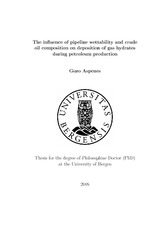The influence of pipeline wettability and crude oil composition on deposition of gas hydrates during petroleum production
Doctoral thesis
Permanent lenke
https://hdl.handle.net/1956/3814Utgivelsesdato
2010-02-05Metadata
Vis full innførselSamlinger
- Department of Chemistry [432]
Sammendrag
At specific temperature and pressure conditions, hydrates can sometimes plug production pipelines. It has been shown that some oils contain natural inhibiting compounds (NICs) that prevent hydrate plug formation even though the pressure and temperature are within the hydrate formation conditions. Thus, the hydrate plugging tendency is influenced by the crude oil composition. The mechanisms by which deposition of hydrates occur in a petroleum production system are also likely to be related to pipeline surface properties, e.g. pipeline material, surface free energy and roughness. The ultimate aim of this work is to develop an understanding of the deposition of hydrates on the pipeline wall. Most of the work in this thesis deals with contact angle measurements that determine the wettability of various solids. Different materials and oil compositions have been tested including both model oil systems and crude oil systems. Micromechanical force experiments have been used to determine the adhesion force between hydrates and solids with different amounts of petroleum acids present in the oil phase. The factors that have been identified in this work as most likely influencing deposition of hydrates to the pipeline wall are the presence of free water, surface material and crude oil composition. It may seem as if hydrate deposition will not occur unless free water is present. When the pipeline wall material has a low surface free energy, such as epoxy coated surfaces, deposition seems to be reduced. Crude oils that are assumed as non-plugging and contain high concentrations of acids seems to reduce the probability for deposition to occur.
Består av
Paper I: Høiland, S.; Borgund, A. E.; Aspenes, G.; Fotland, P., Hydrate Agglomeration and Deposition Studies – HYADES. In: Proceedings of The 19th International Oil Field Chemistry Symposium, March 08, Geilo, Norway. Full text not available in BORA due to publisher restrictions.Paper II: Journal of Colloid and Interface Science 333(2), Aspenes, G.; Høiland, S.; Barth, T.; Askvik, K. M., The influence of petroleum acids and solid surface energy on pipeline wettability in relation to hydrate deposition, pp. 533-539. Copyright 2009 Elsevier Inc. Full text not available in BORA due to publisher restrictions. The published version is available at: http://dx.doi.org/10.1016/j.jcis.2009.01.066
Paper III: Aspenes, G.; Høiland, S.; Barth, T., 2010, Wetting properties of rough epoxy coated pipeline surfaces in relation to gas hydrate deposition. Full text not available in BORA.
Paper IV: Energy & Fuels 24(1), Aspenes, G.; Høiland, S.; Borgund, A. E.; Barth, T., Wettability of petroleum pipelines: influence of crude oil and pipeline material in relation to hydrate deposition, pp. 483-491. Copyright 2009 American Chemical Society. Full text not available in BORA due to publisher restrictions. The published version is available at: http://dx.doi.org/10.1021/ef900809r
Paper V: Aspenes, G.; Balakin, B.; Borgund, A. E.; Høiland, S., Hydrate Agglomeration and Deposition Studies - the influence of pipeline wettability and flow. In: Proceedings of the 20th International Oil Field Chemistry Symposium, March 09, Geilo, Norway. Full text not available in BORA due to publisher restrictions.
Paper VI: Journal of Colloid and Interface Science 343(2), Aspenes, G.; Dieker, L. E.; Aman, Z.; Høiland, S.; Sum, A. K.; Koh, C. A.; Sloan, E. D., Adhesion force between cyclopentane hydrates and solid surface materials, pp. 529-536. Copyright 2009 Elsevier Inc. Full text not available in BORA due to publisher restrictions. The published version is available at: http://dx.doi.org/10.1016/j.jcis.2009.11.071
Paper VII: Aman, Z. M.; Dieker, L. E.; Aspenes, G.; Sum, A. K.; Sloan, A. D.; Koh, C. A., 2010, Influence of model oil with surfactants and amphilic polymers on cyclopentane hydrate adhesion forces. Full text not available in BORA.
